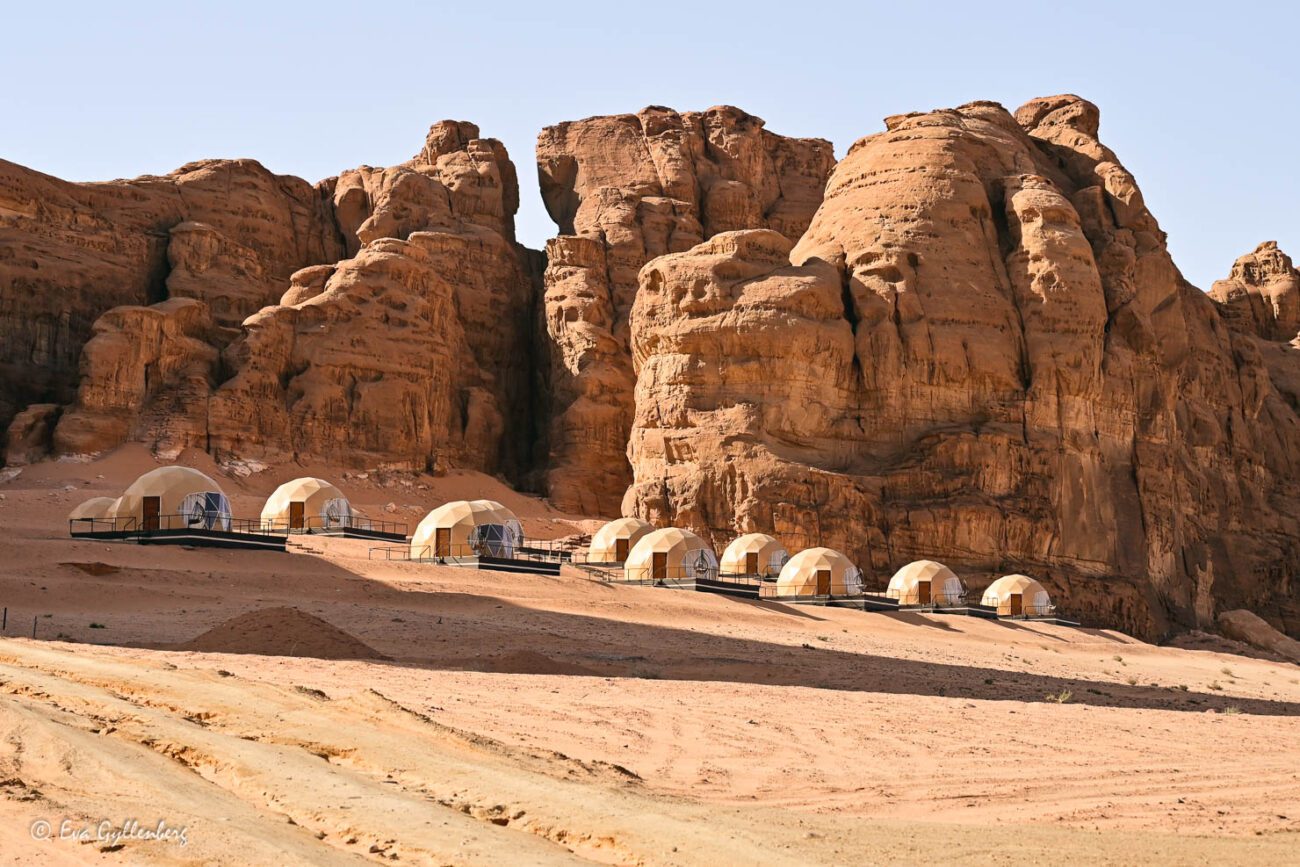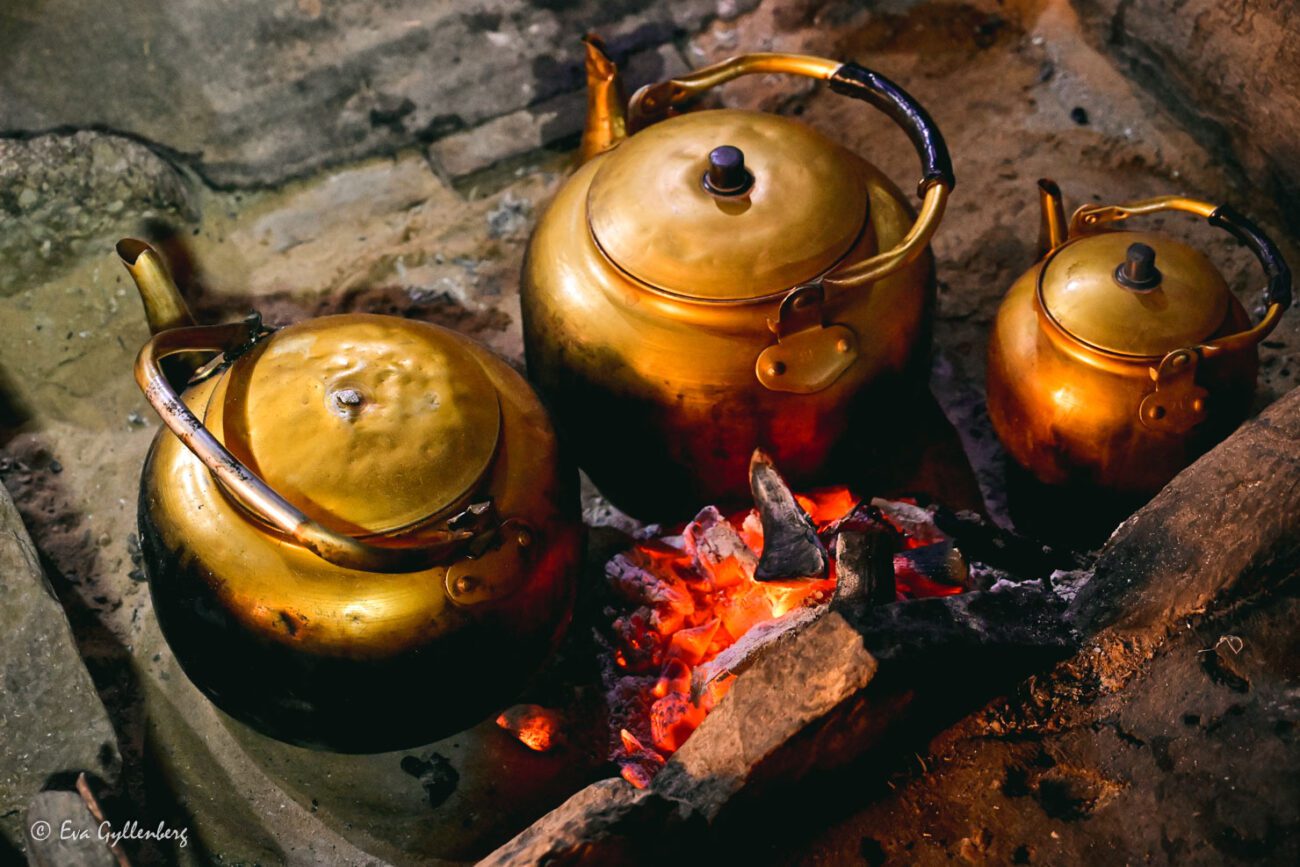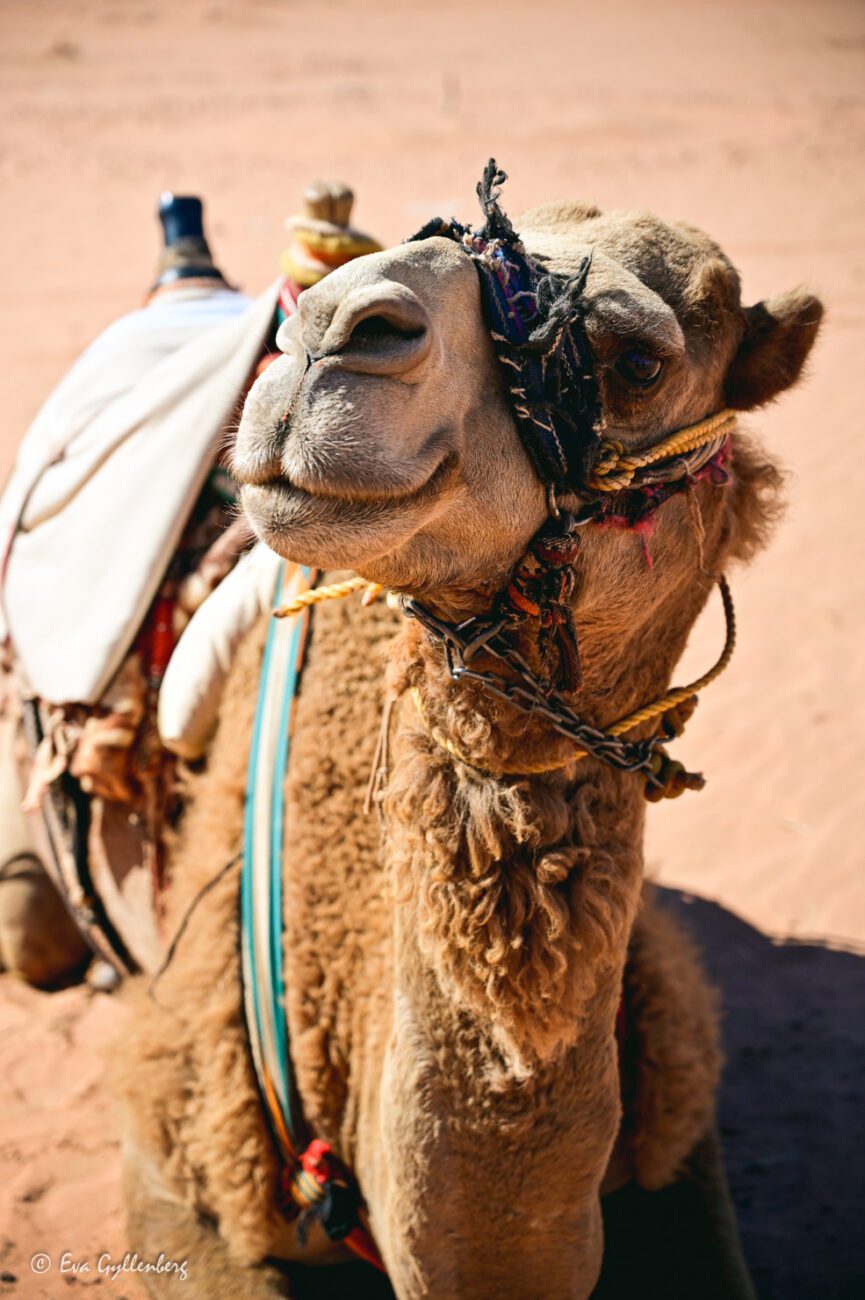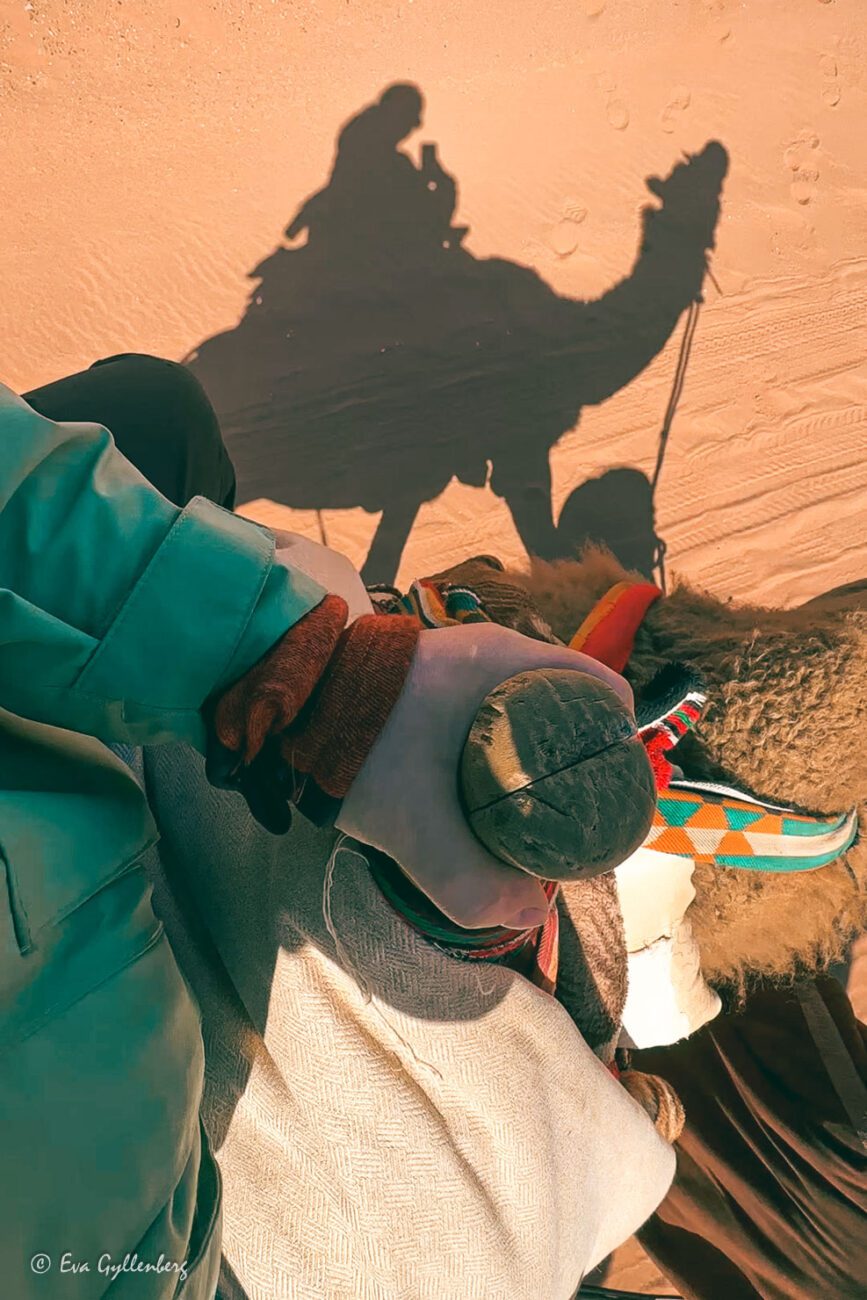Besöket i Wadi Rum gjordes på en pressresa tillsammans med Jordan Tourism Board och Royal Jordanian Airlines, men alla tankar och åsikter är som vanligt mina egna.
Den röda sanden yr bakom den fyrhjulsdrivna bilen som kör oss till vårt boende för natten. Vi sitter uppradade på bänkar på bilflaket och vinden biter tag i mina kinder när bilen studsar fram över sanddynorna. Jag drar upp huvan på min vindjacka och håller i mig hårt. På avstånd ser jag en klase av sandfärgade tältbubblor under en brant klippvägg. Ett av många glampinghotell i Wadi Rum och vårt boende i den majestätiska öknen.


Wadi Rum är ett ökenområde i södra Jordanien, bara några kilometer från gränsen till Saudiarabien. Här i höglandet visar Jordaniens karga ökenlandskap upp sin allra vackraste sida. Här är jorden rödare, klipporna större och nätterna lite mer stjärnklara.
Klippornas dramatiska uttryck med grottor, branter, mesas (platåberg) och stenbågar påminner mig mycket om de röda nationalparkerna på Coloradoplatån i Utah. Ett område som jag älskar och har besökt flertalet gånger. Men det är en stor skillnad mellan de tillrättalagda amerikanska parkerna och Wadi Rums vildmark. Här känns himlen mer oändlig och tystnaden mer närvarande och påtaglig.

Ökenlandskap kan ofta kännas ogästvänliga, men Wadi Rum är inte någon övergiven och obebodd ödemark. Ända sedan förhistorisk tid har nomadfolk levt och verkat här. Deras historiska fotspår och livsberättelser hittar vi idag i områdets 25.000 hällristningar.
Hällristningarna i Wadi Rum visar på livet i öknen – människor som jagar, tama dromedarer och vilda djur som idag är utdöda. Genom olika dateringsmetoder av hällristningar och andra lämningar har man kunnat påvisa att människor levde här redan 10.000 år före Kristus – ungefär samtidigt som den äldre stenåldern tog sina första stapplande steg i Norden. Wadi Rum är onekligen ett unikt och historiskt viktigt område som idag skyddas som ett världsarv av UNESCO.


Den moderna beduinen
Det blåser hård vind, men inne i det randiga beduintältet är det varmt, vindstilla och välkomnande. Tältets tjocka väggar är vävda av får- och kamelull och på marken ligger tjocka handknutna mattor. Det ryker från den glödande brasan i mitten av tältet och de heta kopparkannorna börjar bli redo att servera oss te.
Ordet beduin kommer från det arabiska ordet för ”ökeninvånare” – bedwa. Mer än hälften av Jordaniens befolkning härstammar från beduiner, men det nomadiska livet har de senaste århundradena anpassats till det moderna samhället. Många familjer bor idag i Wadi Rum Village, med närhet till skolor och dricksvatten. Ulltälten har ersatts av hus i betong och dromedarerna har ersatts av fyrhjulsdrivna japanska pickups. Men det finns fortfarande familjer som lever klassiskt nomadliv i Wadi Rum tillsammans med sina får, getter och dromedarer. Den nomadiska själen, gästfriheten och traditionerna lever dock kvar i allt från poesi till musik och familjeliv.


Vi serveras rykande hett te ur en av kopparkannorna samtidigt som den äldsta mannen i tältet tar fram ett stränginstrument och börjar sjunga. Instrumentet består av en trälåda med getskinn och en sträng av hästtagel – en rabada. Världens äldsta stråkinstrument. Orden är melodiösa och sången och tonerna fyller tältet. Beduinernas sånger är ofta poetiska berättelser och kärlek och berättar historier om beduinernas liv. Ett liv med stolta traditioner och ett starkt familjeliv.
Vår guide hjälper oss att översätta våra frågor till arabiska. Männens fruar är hemma och tar hand om familjen och det är kvinnorna som väver tältets tjocka ullväggar. De gamla familjetraditionerna är starka, även om det moderna bylivet blivit vanligare.

Jeepsafari i solnedgången
En av de populäraste aktiviteterna i Wadi Rum är att åka på jeepsafari i solnedgången. Vi får välja om vi vill åka den snabba bilen eller den lite mer långsamma. Jag klättrar upp på flaket på den lite långsammare bilen, men oklart om det blev en långsammare tur då vår bil drar iväg först av alla.
Karavanen av vita Toyota-pickups tar oss lätt fram över ökenlandskapets osynliga vägar. Sanden får bilarna att sladda mjukt och vi flyger över dynorna i sådan fart att det skapar pirr i maggropen.


Vi stannar till och beskådar landskapets klippformationer och dalgångar på flertalet ställen. Sanden driver långsamt i vinden framför oss och skapar ett dimliknande månlandskap mot sandstenen och de höga granitklipporna.
I Jordanien kallas Wadi Rum även för ”måndalen” och det är inte konstigt att Wadi Rum har varit inspelningsplats för flera av de senaste årens rymdäventyr. Dune, The Martian, Star Wars och Prometheus är bara några av de filmer som spelats in här. Kanske är det röda landskapet lite extra passande för filmer som utspelas på Mars – den röda planeten.


Vi stannar bilarna mitt ute i ingenstans och väntar in solnedgången. Landskapets klippor och berg skapar en akvarellmålning med lager på lager av gula och rosa nyanser. Det är bitande kallt och solen går ner snabbt. En kort stund av skönhet som är över fortare än jag hade önskat.


Glamping i ökennatten
Det är tur att vi checkat in på vårt boende i tidigare under dagen och att mobiltelefonen har en ficklampa, annars hade jag nog haft svårt att hitta både till min tältbubbla och rummets lysknappar. Tältet är inte något vanligt tält, utan här finns både ett badrum med dusch och toalett och en stor och bred dubbelsäng. Vissa tält har till och med wifi. Glamping när det är som bäst.
Det serveras en enklare buffémiddag i lägrets huvudbyggnad och trots att klockan inte är mycket fullkomligt kraschar jag i säng. Vinden har ökat i styrka och i vindbyarna känns det nästan som att min sovbubbla lättar från marken – även om jag intalar mig själv att det bara är inbillning.
Jag hinner precis sätta på värmefläkten och släcka lampan när en kraftig vind får elektriciteten att stängas av. Jag kan eventuellt ha tyckt att det var lite läskigt att ligga ensam i en storm i ett kolsvart tält mitt i öknen. Även om jag aldrig skulle erkänna det.
Efter 15 minuter är strömmen tillbaka och jag hinner knappt känna värmefläktens varmluft träffa mitt ansikte förrän jag somnar hårt.


Morgonen därpå vaknar jag till soluppgången. Genom tältets fönster ser jag ut över det milda morgonljuset och en helt fantastisk soluppgång. Jag ligger kvar en stund i sängen och bara beskådar öknens ljusshow från första parkett. Det är svårt att beskriva skönheten i ödsligheten. Bilspåren från igår har sopats bort av vinden. Inga fåglar sjunger och kylan är påtaglig, trots solens nyvakna strålar.
Vi äter en enklare frukost och checkar ut från vårt rymdläger för att uppleva öknen på ett sista sätt innan vi lämnar den.




Dromedarer
Dromedarer är öknens skepp, en pålitlig springare som klarar öknens klimat bättre än något annat riddjur. Dromedaren har i tusentals år varit livsviktig för beduinerna och man behandlar sina dromedarer därefter – med respekt och med kärlek. Mjölken är proteinrik, dromedarullen används till att väva tyger och kamelen kan frakta både människor och varor långa sträckor. En bra dromedar är en investering som lätt kan kosta som en mindre bil.


Vi ska få rida dromedar som ett sista stopp innan vi lämnar Wadi Rum. Jag har ridit dromedar tidigare, men det enda jag minns var att det var lite utmanande att inte ramla ur sadeln när kamelen reser sig.
Jag ställer mig vid en liten dromedar som känns trygg och pratar med den som jag gör med min hund. Fin dromedar. Duktig dromedar. Dromedarens skötare har dock andra planer och pekar att jag ska gå till dromedaren längst fram i ledet.

Jag försöker få en känsla för min nya dromedar. Dromedaren tittar barskt på mig med stora ögon och viftar lite på sina långa ögonfransar. Han visar tydligt att här är det inte jag som bestämmer.
Upp i sadeln och dromedaren reser sig snabbt upp. Min fyrbenta kompis går först tillsammans med skötaren, de andra dromedarerna går i karavan efter. När jag äntligen börjar känna att jag fått in rytmen börjar min kompis att tappa rytmen. Hans tankar är någon annanstans. Blicken flackar. Plötsligt tittar han snett bakåt och slänger ut en stor luftfylld hudsäck genom munnen och utstöter ett högt ljud som påminner om ett bubblande stopp i avloppet. Hela förloppet är över på några sekunder. Vad var det som precis hände? En dromedar lite längre bak i karavanen svarar med samma avloppsljud. Jag har hamnat mitt i en maktkamp mellan två dromedarhanar. Jag känner att mina knogar vitnar lätt när jag håller hårdare kring sadelns knopp.

Dromedarer kan bli upp till 50 år gamla, kan springa 65 km/h och kan klara sig utan mat och vatten i flera veckor.


Vi rider förbi ett blommande fält i öknen. Små blå blommor kämpar med sin överlevnad i detta regnfattiga landskap. Min dromedar stannar till, böjer ned sin långa hals och slukar en blomma. Han går några meter och äter en blomma till. Som tjuren Ferdinand drar han ett djupt andetag och luktar på blommorna innan han äter dem. De andra dromedarerna tittar avundsjukt på. De når inte ner till backen på grund av att de är kopplade.
Ridturen går fort, även om dromedarerna inte går fort. Lite skakig i benen hoppar jag ur sadeln. Att avsluta besöket i Wadi Rum med en ridtur var en fin avslutning på ett besök på en utomjordiskt vacker plats.

Hur besöker jag till Wadi Rum?
Wadi Rum ligger i södra Jordanien, 30 mil söder om Amman. Ökenområdet är 720 km2, vilket motsvarar en yta av halva Öland. Du behöver minst en hel dag för att hinna besöka områdets kända platser och en natt för att uppleva solnedgången och titta på stjärnhimlen i ökennatten. Vi besökte Wadi rum under en rundresa, vilket verkar vara ett väldigt populärt sätt att uppleva landet.
Tänk på att Wadi Rum har heta somrar och kalla vintrar. När vi besökte öknen i mars månad var det perfekt att klä sig i in vindtät jacka med en fleecejacka under. Jag hade nog även gärna haft vantar, då det blir kallt att åka jeep sittandes på flaket. Somrarna kan lätt bli över 40 grader varma, så vår och höst är bäst tid att besöka området.
Vi bodde på Hasan Zawaideh Camp, ett eget inlägg om denna upplevelse planeras.
Vad skulle jag göra annorlunda om jag åkte hit igen?
I Wadi Rum finns flera kända klippor, berg och stenbågar, men för att uppleva dessa behöver du boka en lite längre jeeptur än den vi åkte på. Fråga vilka platser du kommer att få uppleva innan du bokar din tur, så du inte missar någon plats du förväntat dig att se.















alltså wow wow wow!
Tack snälla! Ett helt otroligt ställe! Så vackert!
Vilket härligt inlägg från denna fascinerande plats!
En rundresa i Jordanien med bl a ett dygn i Wadi Rum blev vår sista utomeuropeiska resa innan pandemin och Jordanien blev ett land vi tyckte otroligt mycket om.
Tack för att vi fick en återblick genom dina fina bilder!
Tack snälla du för de fina orden! Gör mig så glad att inlägget gav dig en återblick till detta härliga land. Så mycket historia och magiskt vacker natur, är fortfarande helt tagen efter resan!
Men åhhhh… efter den här artikeln och de otroliga bilderna vill jag dit ännu mer.
Så fint! Längtar tillbaka! Rekommenderar även att söka på ”camel tongue” på TikTok haha.